Last updated: May 23, 2023
Article
Long-term Ecological Monitoring of Mountain Lakes, 2013
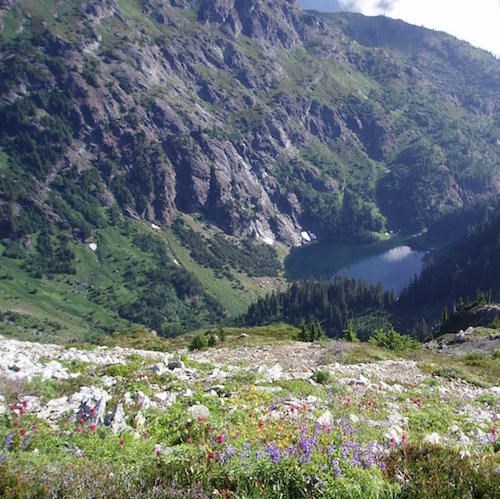
Importance
Shrouded by clouds, mist, and snow for much of the year, high mountain lakes are ideal locations to assess environmental change affecting the high country of the Pacific Northwest. Mountain lakes integrate the effects of multiple stressors, such as climate change, air pollution, and visitor impacts, from over a broad area into a suite of chemical and biological characteristics that essentially make them living Petri dishes. Given their high elevation, mountain lakes are particularly susceptible to the effects of atmospheric pollution. Pollutants such as nitrogen, ammo-nium, sulfur, and various contaminants (e.g. mercury, semi-volatile organic pollutants) are deposited from air masses that originate from industrialized areas. Mount Rainier National Park receives pollutants from the rapidly growing Puget Sound, Portland and Frasier Valley metropolitan areas as well as from trans-Pacific sources. Fish stocking in all three parks has altered native lake food web structure and nutrient dynamics. Global climate change is predicted to impact mountain lakes systems in a variety of ways. Increased air and water temperature can change the timing and duration of ice cover. Since these systems are ice-free only a fraction of the year, change in ice cover will fundamentally alter foodweb interactions, species diversity, and nutrient dynamics. Increased temperatures may also change the timing and amount of glacial and snow melt-water inputs to lakes, causing changes to hydrologic regimes that affect nutrient concentrations and foodwebs. Amphibians are essential components of mountain lake foodwebs. Their abundance and diversity can be altered by the introduction of non-native predators and diseases. Several diseases affecting amphibians are thought to be influenced by global climate change and visitor impacts. Many network lakes have historically been stocked with non-native fish, fundamentally altering biological community structure and nutrient dynamics. Lake monitoring data will provide baseline data to predict future changes in these vital park ecosystems.
Management Applications
This information will provide for a:
- Better understanding of impacts of atmospheric pollution
- Better understanding of impacts of global climate change
- Development of criteria for restoring lakes impacts by non-native species
- Identification of impacts associated with backcountry visitation
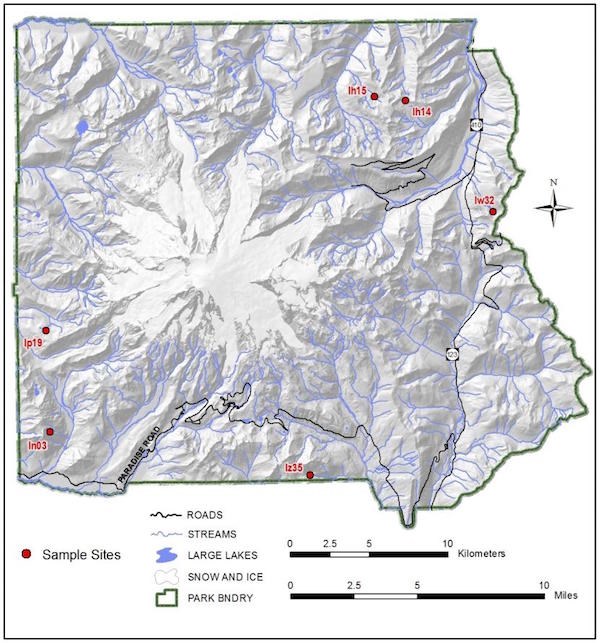
Methods
Mount Rainier lakes have been studied since 1988. Current long-term ecological monitoring has been ongoing at Reflection, Louise, Mowich, Ethel, and the six North Coast and Cascades (NCCN) Mountain Lake Monitoring sites: Blue, Allen, Upper Palisades, Upper Deadwood, and two unnamed park lakes. The NCCN long-term ecological monitoring program also includes lakes in North Cascades and Olympic National Park. Future monitoring will focus on these NCCN long-term ecological monitoring lakes. NCCN Study site lakes were randomly selected from target populations of lakes that meet certain criteria in an attempt to standardize the type of lake sampled. Study lakes for each park are illustrated in Figures 2-4. These criteria are:
- Lakes are entirely within park boundaries
- Lakes have surface areas ranging from 0.4 to 6.0 ha
- Lakes ranging in elevation from 1220m to the upper limit of the subalpine zone
- Lakes are not heavily influenced by glacial runoff
- Lakes are safely accessible on foot by trail of off trails during August and September
- Lakes have maximum depths >2.5m
- Lakes do not have high densities of fish.
Study site lakes are visited once for sampling during mid-summer (August through early September in most years), to approximate the middle of the ice-free plankton growing season. A variety of physical, chemical and biological parameters are sampled during each visit. Water chemistry, chlorophyll-a, zooplankton, Secchi depth and water column profiles (dissolved oxygen, temperature, pH, specific conductivity) are sampled at a permanent sampling buoy located at the deepest point in each lake. Air temperature and water temperature at the surface, mid-depth and bottom depth are recorded continuously throughout the year by temperature dataloggers deployed at the sampling buoy. Water level is measured at two stations located on each lake shoreline. Complete shoreline and snorkel surveys are used for recording observations of amphibians Fish are monitored by gill nets or hook and line. Zooplankton, benthic macroinvertebrates samples are collected. Lake riparian conditions are also monitored to document natural disturbance and impacts from recreational use. Details related to the sampling design can be found in the draft protocol (Glesne et al.2012).
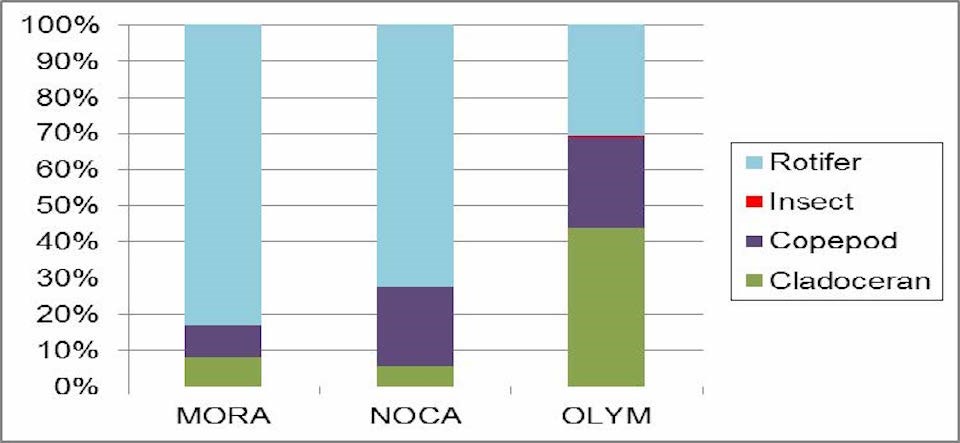
Status and Tends
Limited data analysis on the long-term monitoring lakes has been conducted to date. Zooplankton species were analyzed for the six NCCN long-term ecological monitoring lakes and compared with species present in North Cascades and Olympic National Parks. The cladoceran Holopedium gibberum, found almost ubiquitously across Mount Rainier lakes, was found only in Mount Rainer. Mount Rainier lakes had the most taxa (average of 11.2), while Olympic lakes had the fewest (average of 7.16). NOCA lakes had an average of 9.0 taxa. These data suggest that there are regional differences within the NCCN parks in species pools and factors that structure zooplankton communities.
Seven taxa contributed most to the community structure at Mount Rainier. Of these, the colonial rotifer C. unicornis, the cladoceran H. gibberum, and juvenile copepods had the most consistent presence across Mount Rainier lakes. Major zooplankton taxonomic groups in study site lakes for all three national parks is presented in Figure 1.

An example of temperature and water chemistry results for Blue Lake, located in the southern portion of the park, is presented in Table 1 and Figure 2. A continuous water temperature example (Fig. 6), and lake bathymetry mapping example (Fig. 7) are also presented.
Table 1. Water quality and productivity parameters for Blue Lake 2010. Water samples collected at multiple depths due to lake stratification. Chlorophyll was sampled at mid-depth.
| Parameter | Units | 2010 1 m |
2010 11.0 m |
| Water Chemistry | |||
| Total Nitrogen | mg/l | 0.03 | 0.08 |
| Total Phosphorus | mg/l | 0.003 | 0.005 |
| Nitrogen & Phosphorus Ratio | N/A | 10 | 16 |
| NO3+NO2-N | mg/l | *0.000 | 0.005 |
| NH3-N | mg/l | *0.002 | 0.022 |
| Anion & Cation Ratio | N/A | N/A | |
| Acid Neutralizing Capacity | µeq/L | 180 | 180 |
| pH | None | 5.69 | 5.68 |
| Specific Conductance | µS/cm | 12 | 26 |
| Dissolved Organic Carbon | mg/l | 0.75 | |
| Total Dissolved Solids | mg/l | 0.03 | 0.08 |
| Water Clarity | |||
| Depth of Transparency | m | 9.4 | |
| Chlorophyll | |||
| Chlorophyll-a | µg/L | 0.372 | |
| *Below Detection Limit |
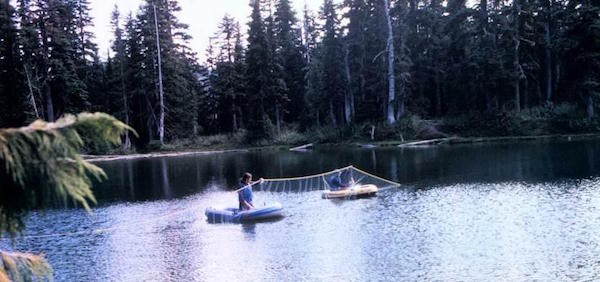
Introduced fish are present in four of the six long-term monitoring lakes and in about 30 total lakes in Mount Rainier. Fish species found in park lakes include: Eastern brook trout (Salvelinus fontinalis), rainbow trout (Onchorynchus mykiss), cutthroat trout (Oncorhynchus clarkii lewisi), prickly sculpin (Cottus asper), and kokanee (Onchrhynchus nerka) at Mowich Lake.
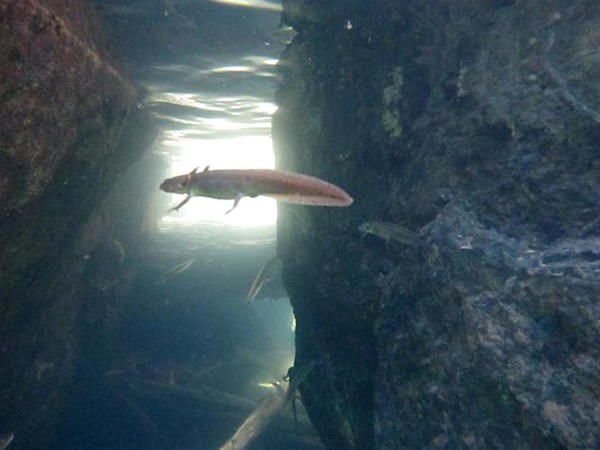
Nine species of amphibians are present in park lakes including the northwest salamander (Ambystoma gracile, Figure 4), long-toed salamander (Ambystoma macrodactylum), coastal giant salamander (Dicamptodon tenebrosus), Van dyke’s salamander (Plethodon vandykei), Cascades frog (Rana cascadae), Pacific tree frog (Pseudacris regilla), tailed frog (Ascaphus truei), western toad (Anaxyrus boreas), and rough-skinned newt (Taricha granulosa).



